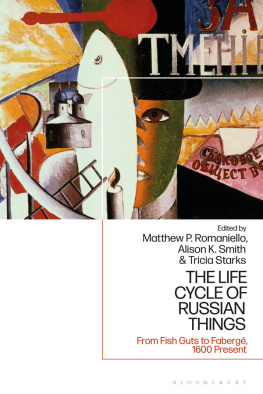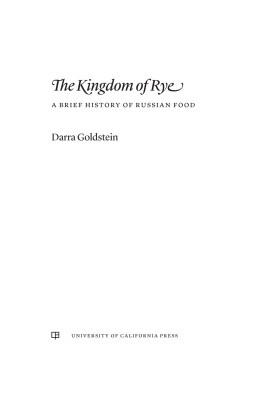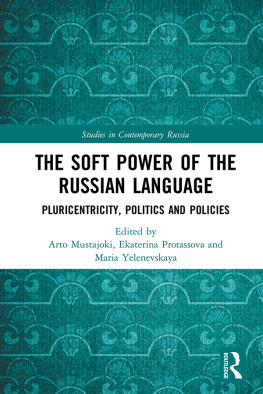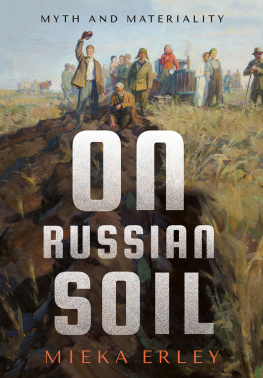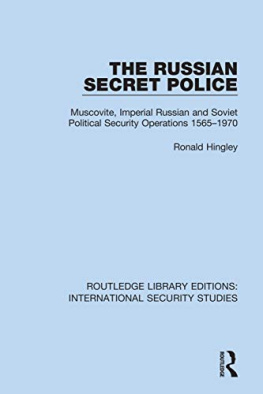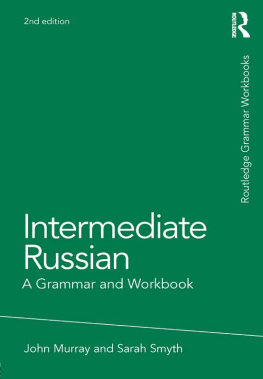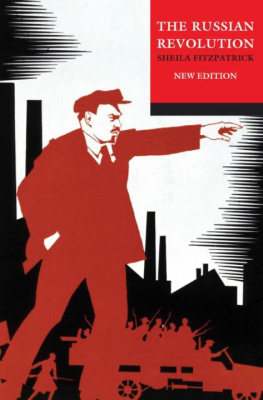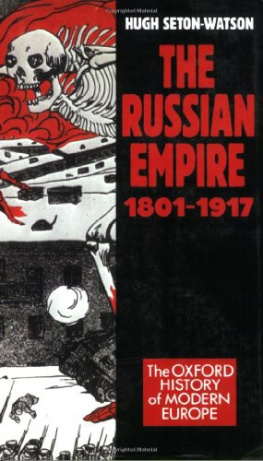
The Life Cycle of Russian Things
The Life Cycle of Russian Things
From Fish Guts to Faberg, 1600Present
Edited by
Matthew P. Romaniello, Alison K. Smith, and Tricia Starks

BLOOMSBURY ACADEMIC
Bloomsbury Publishing Plc
50 Bedford Square, London, WC1B 3DP, UK
1385 Broadway, New York, NY 10018, USA
29 Earlsfort Terrace, Dublin 2, Ireland
BLOOMSBURY, BLOOMSBURY ACADEMIC and the Diana logo are trademarks of Bloomsbury Publishing Plc
First published in Great Britain 2022
Copyright Matthew P. Romaniello, Alison K. Smith, and Tricia Starks, 2022
Matthew P. Romaniello, Alison K. Smith, and Tricia Starks have asserted their right under the Copyright, Designs and Patents Act, 1988, to be identified as Editors of this work.
For legal purposes the constitute an extension of this copyright page.
Cover image: Print Collector/Getty Images.
All rights reserved. No part of this publication may be reproduced or transmitted in any form or by any means, electronic or mechanical, including photocopying, recording, or any information storage or retrieval system, without prior permission in writing from the publishers.
Bloomsbury Publishing Plc does not have any control over, or responsibility for, any third-party websites referred to or in this book. All internet addresses given in this book were correct at the time of going to press. The editors and publisher regret any inconvenience caused if addresses have changed or sites have ceased to exist, but can accept no responsibility for any such changes.
Every effort has been made to trace copyright holders and to obtain their permissions for the use of copyright material. The publisher apologizes for any errors or omissions and would be grateful if notified of any corrections that should be incorporated in future reprints or editions of this book.
A catalogue record for this book is available from the British Library.
Library of Congress Cataloging-in-Publication Data
Names: Smith, Alison Karen, editor, author. | Romaniello, Matthew P.,
editor, author. | Starks, Tricia, 1969 editor, author.
Title: The life cycle of Russian things : from fish guts to Faberge,
1600present / edited by Matthew P. Romaniello, Alison K. Smith, and Tricia Starks.
Description: First edition. | London ; New York : Bloomsbury Academic,
2021. | Includes bibliographical references and index. |
Identifiers: LCCN 2021012902 (print) | LCCN 2021012903 (ebook) |
ISBN 9781350186026 (hardback) | ISBN 9781350186033 (ebook) |
ISBN 9781350186040 (epub)
Subjects: LCSH: RussiaSocial life and customs. | Soviet UnionSocial
life and customs. | Russia (Federation)Social life and customs. |
Material cultureRussiaHistory. | Material cultureSoviet
UnionHistory. | Material cultureRussia (Federation)History. |
Consumption (Economics)Social aspectsHistory.
Classification: LCC DK32 .L67 2021 (print) | LCC DK32 (ebook) | DDC 947dc23
LC record available at https://lccn.loc.gov/2021012902
LC ebook record available at https://lccn.loc.gov/2021012903
ISBN: HB: 978-1-3501-8602-6
ePDF: 978-1-3501-8603-3
eBook: 978-1-3501-8604-0
To find out more about our authors and books visit www.bloomsbury.com and sign up for our newsletters.
Contents
Matthew P. Romaniello, Alison K. Smith, and Tricia Starks
Clare Griffin
Alison K. Smith
Ann Komaromi
Matthew P. Romaniello
Katherine Pickering Antonova
Charles Steinwedel
Audra Yoder
Tricia Starks
Brandon Schechter
Erika Monahan
Marisa Karyl Franz
Ulrike Schmiegelt-Rietig
Katherine Pickering Antonova is Associate Professor of History at Queens College, City University of New York, United States. She is the author of The Essential Guide to Writing History Essays (2020) and An Ordinary Marriage: The World of a Gentry Family in Provincial Russia (2013). She is currently writing Holy Men and Troublesome Women: Policing Faith in Russia after Napoleon and researching a book about textile hand production in Russia and the Soviet Union.
Marisa Karyl Franz is a faculty fellow in museum studies at New York University, United States. She is the author of A Visitors Guide to Shamans and Shamanism: The Kunstkameras Russian and Asian Ethnographic Collections in the Late Imperial Era. She is currently working on her manuscript Near and Desired Things: Desiderata and the Collection of Shamanic Materials for Local Siberian Museums, 18801910 .
Clare Griffin is Assistant Professor of the History of Science and Technology at Nazarbayev University, Republic of Kazakhstan. She has published several articles on science and medicine in early modern Russia in journals such as the Journal of Global History (2020). She is also the coeditor of Perpetual Motion? Transition and Transformation in Central and Eastern Europe & Russia (2011) and the special edition The Natural Turn in Early Modern Russian History, for I: E-Journal of Eighteenth-Century Russian Studies (2018). She is currently writing Material Worlds: Materia Medica and the Global History of Early Modern Russian Medicine.
Ann L. Komaromi is Associate Professor of Comparative Literature and Slavic Languages and Literatures at the University of Toronto, Canada. She is the author of Uncensored: The Quest for Autonomy in Soviet Samizdat (2015) and the electronic Project for the Study of Dissidence and Samizdat (2015). She is currently finishing a book on Soviet uncensored periodicals and publics, and she is working on studies of dissidence and the late Soviet avant-garde in comparative perspective.
Erika Monahan is Associate Professor of History at the University of New Mexico, United States. She is the author of The Merchants of Siberia: Trade in Early Modern Eurasia (2016) and Locating Rhubarb: Early Modernitys Relevant Obscurity, in Early Modern Things: Objects and Their Histories (2013), and coeditor of Seeing Muscovy Anew: PoliticsInstitutionsCulture (2017) with M. Flier, V. Kivelson, and D. Rowland. She is now working on two books, one about the early mapping of Russia and an expanded second edition of Lindsey Hughess The Romanovs: 16131917. She is the book review editor for Canadian-American Slavic Studies.
Matthew P. Romaniello is Associate Professor of History at Weber State University, United States. He is the author of Enterprising Empires: Russia and Britain in Eighteenth-Century Eurasia (2019) and The Elusive Empire: Kazan and the Creation of Russia, 15521671 (2012). He is also the editor of the Journal of World History and five edited volumes, including Russia in Asia: Imaginations, Interactions, and Realties (2020) with J. Hacking and J. Hardy. He is currently writing Humoring Russia: Body Politics in the Eighteenth Century.
Brandon Schechter has taught at NYU, Columbia, Brown, and UC Berkeley in the United States. He is the author of The Stuff of Soldiers: A History of the Red Army in World War II through Objects (2019) as well as articles in Ab Imperio , Kritika , and the Journal of Power Institutions of Post-Soviet Societies . He is currently working on The Search for Salvation in the Second World War , which compares the work of political officers in the Red Army with chaplains in the US Army.
Ulrike Schmiegelt-Rietig is Provenance Researcher at the Stiftung Preuische Schlsser und Grten in Potsdam, Germany. She is author of Eine Geschichte von Heiligen und Helden. Das Bildprogramm der Vladimirkathedrale in Kiev (2018) and coauthor, together with Corinna Kuhr-Korolev and Elena Zubkova, of Raub und Rettung. Russische Museen im Zweiten Weltkrieg (2019). She is also teaching museum methodologies and exhibition narratives at the Department of Material Culture of the Carl von Ossietzky-University of Oldenburg, Germany.
Next page
